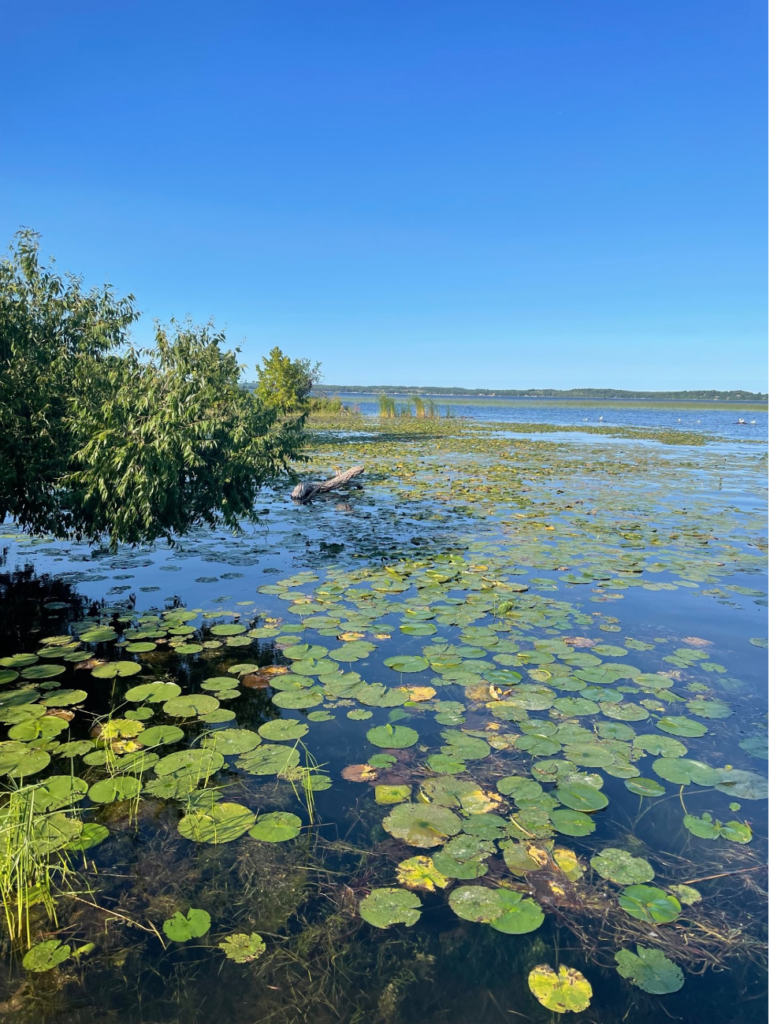Clay County Histories
Markus Krueger | Program Director HCSCC

Pelican Lake Beyond the Timber (Lake Lida)
Wayne Gudmundson, the artist and retired MSUM photography professor, recently brought to my attention a list of 923 Ojibwe place names compiled by Reverend Joseph Alexander Gilfillan, an Episcopal missionary at White Earth Reservation from 1873 to 1908. I thought I’d share a few with you.
I use Rev. Gilfillan’s phonetic spellings of Ojibwe words here, but you might want to check the Ojibwe People’s Dictionary (www.ojibwe.lib.umn.edu) for the standard modern spellings before you carve a sign for the cabin or get a new tattoo. Ojibwe in his day was spoken more than written, and one writer spelled those sounds differently than another. Gilfillan, for instance, spelled Lake Superior (“The Great Water”) Ki’-chi-gum’-i, but it is spelled Gichigami in standard modern Ojibwe. In fact, say the word “Chippewa” five times in a row and you’ll hear for yourself that it is the word “Ojibwe” spelled differently.
The Red River was called Ki’-chi zi’-bi, which means “the Great River.” I like that! The Mississippi River was called also called Ki’-chi zi’-bi, but the reverend notes that it must have previously been called Mis’-sa’ zi’-bi (“The Everywhere River”) since that is what we call it today. Mille Lac Lake was called the “The Everywhere Lake” due to its size.
One of the patterns I found very interesting and perhaps a little reassuring is that so many of the place names we use today are the English translations of the original Ojibwe names. Round Lake, Strawberry Lake, Otter Tail Lake and River, and Maple River are among the hundreds of examples where white residents and cartographers kept Ojibwe names. As was Grand Forks (Ki’-chi ma’-da’-wank), named for the confluence of the Red River and Red Lake River. The Wild Rice River (the one on the Minnesota side that flows through Ulen and Norman County) gets its name from the Ojibwe “The River of the Place of the Wild Rice Plant Growing.” Pi’-zhi-ki’-wi zi’-bi (“Buffalo River”) was the name of the river as well as the town of Glyndon.
Cities had their own Ojibwe names. Moorhead and Fargo were collectively called Ash’-o-ge’-mog ki’-chi zi’-bi, “The Crossing of the Great River.” Ada was Bayou River. Frazee was “Where the Road Passes Out of the Timber.” Duluth was “The Little Portage,” I assume in comparison with Grand Portage further north. Minneapolis was Ki’-chi ka-kab-i-ka, “The Great Falls,” referring to St. Anthony Falls. And I saw two “Little Falls” (Ka’-kab’-ik-ans’): Little Falls and Fergus Falls.
Detroit Lake was called Ga-a’-zha-wa’ ang-gag’ za’-gai-i-gum – “The Lake Through Which There is a Crossing on the Sandy Bar.” The city on its shore was “The Town of the Crossing on the Sandy Bar.”
I saw three Pelican Lakes of note on that list. “Pelican Lake in the Midst of the Timber” (Star Lake), “Pelican Lake Beyond the Timber” (Lake Lida), and regular old “Pelican Lake” in Crow Wing County. What we call Pelican Lake in Otter Tail County was called “The Lake with the Smooth Shore Prairie Coming Down to it on One Side.” The lakes surrounding Lake Park were collectively known as “The Lakes Where There are Streams, Groves, Prairies and a Beautiful Diversified Country.”

